The Ultimate Guide to Pearl Necklace Care: Expert Tips and FAQs

Pearl necklaces are timeless and elegant accessories that individuals have cherished for centuries.
However, as with fine jewellery, pearl necklaces require proper care and maintenance to preserve their natural beauty and longevity.
So, here is a complete guide on the types of pearls and how to take care of them.
Understanding Pearl Types
Discover the enchanting world of pearls and gain a deeper understanding of their diverse types.
Natural Pearls
Natural pearls are rare and highly prized for their organic formation and are created entirely by chance when an irritant, such as a grain of sand, enters the mollusc's shell.
Cultured Pearls
Cultured pearls are created through a deliberate process by pearl farmers and can closely resemble natural pearls in appearance.
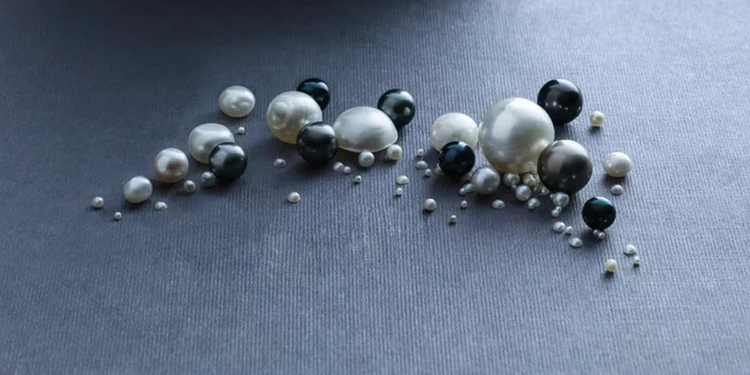
Freshwater Pearls
Freshwater pearls are cultivated in freshwater environments, such as lakes and rivers.
They are typically produced by mussels rather than oysters, responsible for most saltwater pearls.
Akoya Pearls
Akoya pearls are known for their exceptional lustre and classic round shape and are primarily cultivated in Japan.
South Sea Pearls
South Sea pearls are considered the pinnacle of luxury for pearl jewellery.
The exceptional size and quality of South Sea pearls make them a symbol of sophistication and elegance.
Tahitian Pearls
Tahitian pearls, also known as black pearls, are cultivated primarily in French Polynesia.
These pearls are renowned for their unique and captivating colours.
Factors Affecting Pearl Necklace Care
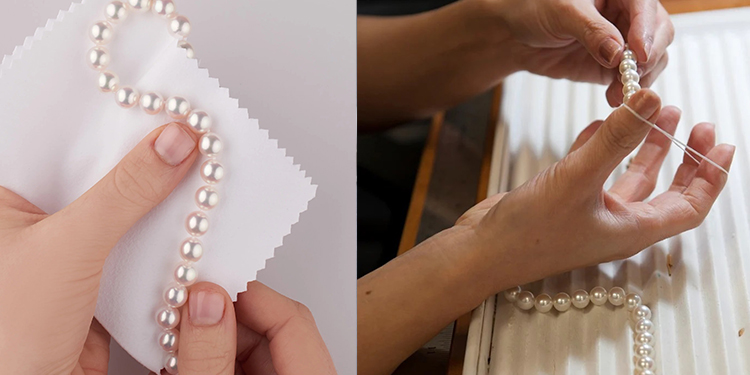
Listed below are the factors affecting pearl necklace care:
Environmental Factors
Environmental factors affecting pearl necklace care:
Temperature
Extreme temperatures can adversely affect the quality and lustre of pearl necklaces.
Pearls are sensitive to temperature changes, particularly high heat, which can cause them to become dull, discoloured, or even crack.
Humidity
Pearls thrive in a humid environment, requiring moisture to maintain their natural lustre.
However, excessive humidity can cause pearls to absorb moisture and become dull or develop mould.
Light exposure
Prolonged exposure to direct sunlight or intense artificial light can fade the colour of pearls over time.
Pearls should be stored in a dark place or a jewellery box with a soft lining.
Chemical Exposure
Exposing pearls to chemicals can affect their overall look, so keep your pearls away from:
Perfumes and cosmetics
Pearls are susceptible to acidic substances in perfumes, hairsprays, lotions, and other cosmetics.
Cleaning products
Household cleaning agents, including bleach, ammonia, and chlorine-based products, can be extremely damaging to pearls.
Hair products
Hair products such as hairspray, mousse, or gel can contain harmful chemicals to pearls.
Spraying or applying these products directly onto the hair can cause the pearls to become coated with a sticky residue.
Wear and Tear
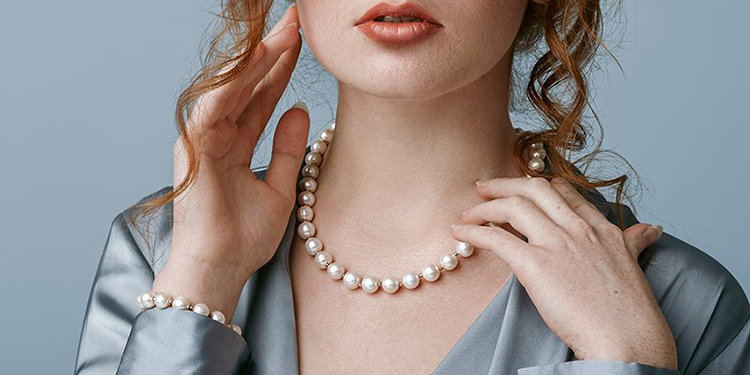
Wear and tear is a significant factor affecting pearl necklace care.
Everyday wear
While pearls are resilient gemstones, they are also delicate and can be easily scratched or damaged by everyday activities.
Special occasions
Pearl necklaces are often worn for special occasions or formal events.
However, it is crucial to consider the activities involved and the potential risks they pose to the pearls. For example, swimming and exercising.
Storage
Proper storage is essential to maintain the beauty and longevity of pearl necklaces.
Pearls should be stored separately from other jewellery items to prevent scratching or tangling.
Cleaning and Maintenance
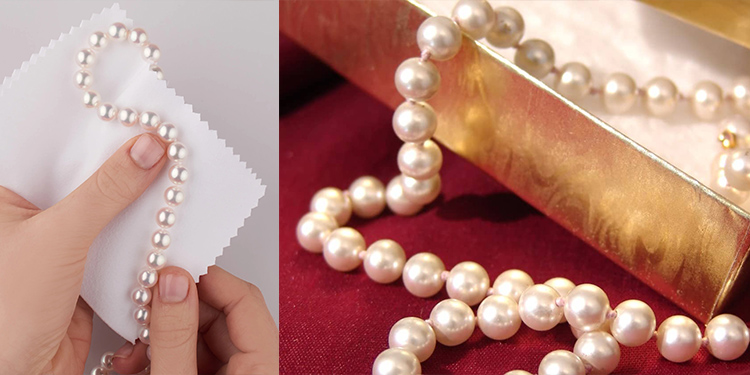
If you want to keep your pearls in good condition, take care of their cleaning and maintenance.
Daily cleaning routine
A daily cleaning routine is essential to keep your jewellery looking its best.
Wiping with a soft cloth
One of the easiest and most effective ways to clean your jewellery daily is by gently wiping it with a soft cloth.
Removing body oils and perspiration
Our bodies naturally produce oils and perspiration that can dull the shine of jewellery over time.
Make it a habit to remove your jewellery before engaging in activities that may cause excessive sweating.
Periodic Cleaning Methods
While a daily cleaning routine is important, periodic deep cleaning is necessary to maintain your jewellery's long-term beauty and integrity.
Here are two effective methods for more thorough cleaning:
Mild soap and water
For most types of jewellery, gentle cleaning with mild soap and lukewarm water can work wonders.
Commercial pearl cleaning solutions
Pearls require special care due to their delicate nature, so opt for a commercial pearl cleaning solution specifically formulated for these precious gems.
Professional Cleaning Services
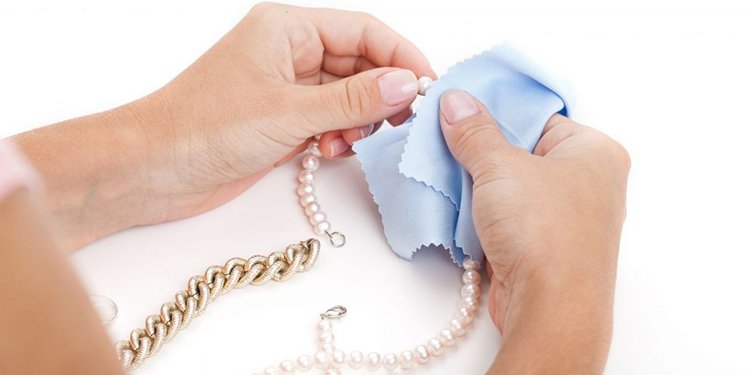
While daily cleaning and periodic care can go a long way, there are times when seeking professional cleaning services becomes necessary.
When to seek professional cleaning
If regular cleaning methods fail to remove stubborn dirt or grime from your pearl necklace, it may be time to seek professional assistance.
Choosing a reputable jeweller
Choosing a reputable and experienced professional is crucial when selecting a jeweller for professional cleaning.
Look for jewellers who have a proven track record in the industry.
Storing Your Pearl Necklace
Here are some tips on how you should store your pearls
Storage Tips
By following these storage tips, you can ensure that your precious pearls remain protected and free from damage.
Soft pouches or jewellery boxes
Store your pearl necklace in a soft pouch or a jewellery box specifically designed for pearls to safeguard your pearl necklace from scratches or tangling.
Individual wrapping
If you prefer to store multiple pieces of jewellery together, ensure each pearl necklace is individually wrapped in a soft cloth or tissue paper.
Separation from other jewellery
Avoid storing your pearl necklace with other jewellery items, especially those made from metal or gemstones that could scratch or damage the pearls.

Travelling with Pearl Necklaces
When you're on the go, taking proper precautions is crucial to protect your pearl necklace from any potential damage.
Here are some tips for travelling with your precious pearls:
Travel cases
Invest in a travel case specifically designed for jewellery, preferably one that offers individual compartments or pouches.
Precautions during transportation
While travelling, make sure to keep your pearl necklace in a safe and secure place.
Avoid placing it in checked luggage.
Handling and Wearing Pearls
Let us look at some of the handling and wearing techniques for pearls.
Proper Handling Techniques
Proper handling techniques for pearls are essential to preserve their delicate beauty and prevent damage.
Here are some guidelines to follow:
Clean hands
Before handling your pearls, ensure your hands are clean and free from oils, lotions, or cosmetics.
These substances can transfer to the pearls and affect their lustre over time.
Gentle touch
Pearls are delicate and can easily be scratched or chipped.
Handle them with a gentle touch, avoiding excessive force or pressure.
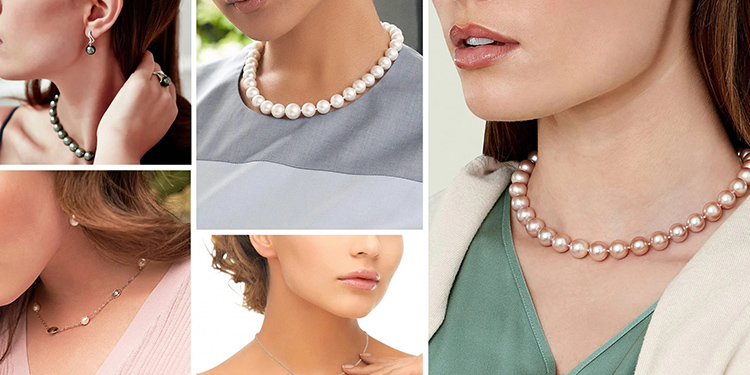
Wearing Guidelines
Wearing pearls with care ensures they remain beautiful and retain their value over time.
Consider the following guidelines when wearing your pearls:
Last-on, first-off rule
To minimise the exposure of your pearls to substances that could potentially harm them, follow the "last-on, first-off" rule.
After applying perfumes, lotions, and cosmetics, you should put your pearls on as the last step in your grooming routine.
Avoiding exposure to harsh elements
Pearls are vulnerable to extreme temperatures, sunlight, and moisture.
To preserve their beauty, avoid wearing your pearls in situations where they may be exposed to excessive heat, direct sunlight, or prolonged periods of high humidity.
Following these recommendations, you can ensure that your pearls remain radiant and retain their natural allure for generations.
Repairing and Restringing
Here is all about repairing and restringing pearls:
Recognising signs of damage
Here are some common signs of damage to watch for:
Loose pearls
If you notice any loose pearls or gaps between them on your necklace or bracelet, it may indicate that the stringing material has weakened or stretched.
Broken clasp
If your clasp is broken, damaged, or no longer functions properly, it is important to have it repaired or replaced.
Worn-out string
If you see signs of wear or notice any breaks or knots in the string, it's time to consider restringing your pearls.
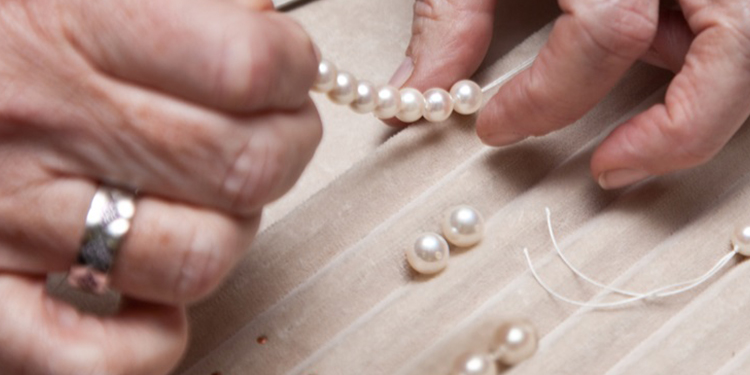
Professional Repairs and Restringing
When significant repairs or restringing is needed, it is advisable to seek the assistance of a professional jeweller or pearl specialist. Here's what you need to do:
Choose a reputable professional
Look for a jeweller or pearl specialist with experience handling and repairing pearls.
Seek recommendations from friends, family, or online reviews to find a reputable professional.
Professional restringing
Restringing pearls involves removing the old string and carefully threading the pearls onto a new, high-quality string.
DIY repairs and maintenance
While certain repairs and restringing are best for professionals, you can perform DIY repairs and maintenance tasks to keep your pearls in good condition.
Some of them include regular inspection, storage maintenance, and basic cleaning.
Pearl Necklace Care FAQs
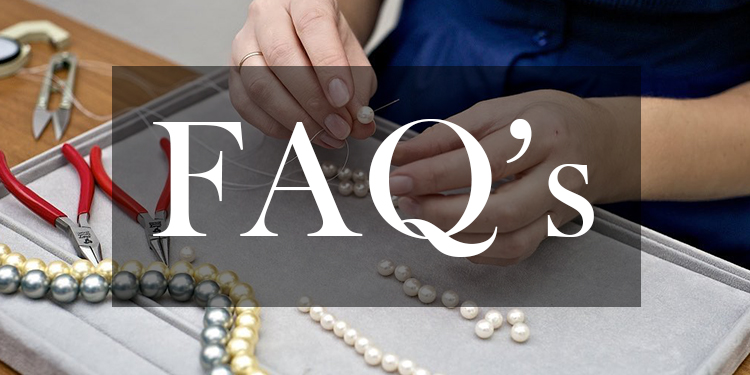
How often should I clean my pearl necklace?
Clean your pearl necklace every few months.
Can I wear my pearl necklace in the shower?
It's best to avoid wearing your pearl necklace in the shower.
What should I do if my pearl necklace gets wet?
If your pearl necklace gets wet, gently dry it with a soft cloth.
How can I prevent my pearl necklace from tarnishing?
Prevent tarnishing by keeping your pearl necklace away from chemicals and acids.
Can I store my pearl necklace in a plastic bag?
It's not recommended to store your pearl necklace in a plastic bag.
Can I wear my pearl necklace with other jewellery?
Yes, you can wear your pearl necklace with other jewellery.
How can I tell if my pearls are real or fake?
To determine if your pearls are real or fake, look for surface imperfections and perform a tooth test.
Are pearl necklaces suitable for everyday wear?
Pearl necklaces are suitable for everyday wear.
Can I wear my pearl necklace while exercising?
It's advisable to remove your pearl necklace while exercising.
How long do pearl necklaces typically last?
Pearl necklaces can last a lifetime with proper care.
Conclusion
Proper care and maintenance are crucial for preserving the beauty and longevity of your pearl necklace.
Regular cleaning every few months helps remove dirt and oils that can dull the pearls' lustre.
Storing your pearls in a soft cloth or pouch, away from other jewellery, helps prevent scratching.
Finally, remember to remove your pearl necklace before engaging in activities such as exercising or showering to minimise the risk of damage.


Leave a Comment